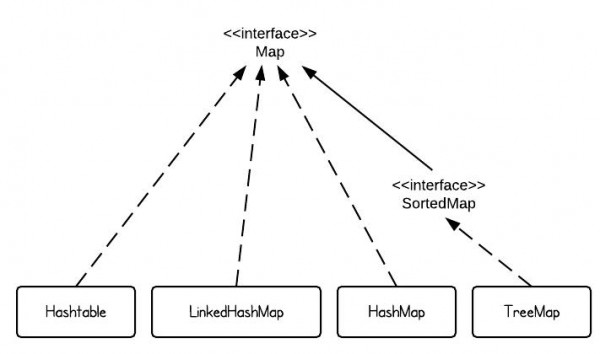HashMap VS. TreeMap VS. HashTable VS. LinkedHashMap
来源:互联网 发布:伦敦金2016年历史数据 编辑:程序博客网 时间:2024/06/10 05:05
Map is one of the most important data structures. In this tutorial, I will show you how to use different maps such as HashMap, TreeMap, HashTable and LinkedHashMap.
1. Map Overview

There are 4 commonly used implementations of Map in Java SE – HashMap, TreeMap, Hashtable and LinkedHashMap. If we use one sentence to describe each implementation, it would be the following:
- HashMap is implemented as a hash table, and there is no ordering on keys or values.
- TreeMap is implemented based on red-black tree structure, and it is ordered by the key.
- LinkedHashMap preserves the insertion order
- Hashtable is synchronized, in contrast to HashMap.
This gives us the reason that HashMap should be used if it is thread-safe, since Hashtable has overhead for synchronization.
2. HashMap
If key of the HashMap is self-defined objects, then equals() and hashCode() contract need to be followed.
import java.util.HashMap;import java.util.Map.Entry;public class Main {public static class Dog {String color;Dog(String c) {color = c;}public String toString() {return color + " dog";}}public static void main(String[] args) {HashMap<Dog, Integer> hashMap = new HashMap<Dog, Integer>();Dog d1 = new Dog("red");Dog d2 = new Dog("black");Dog d3 = new Dog("white");Dog d4 = new Dog("white");hashMap.put(d1, 10);hashMap.put(d2, 15);hashMap.put(d3, 5);hashMap.put(d4, 20);// print sizeSystem.out.println(hashMap.size());// loop HashMapfor (Entry<Dog, Integer> entry : hashMap.entrySet()) {System.out.println(entry.getKey().toString() + " - "+ entry.getValue());}}}Output:
4white dog - 5black dog - 15red dog - 10white dog - 20
Note here, we add “white dogs” twice by mistake, but the HashMap takes it. This does not make sense, because now we are confused how many white dogs are really there.
The Dog class should be defined as follows:
public static class Dog {String color; Dog(String c) {color = c;} public boolean equals(Object o) {return ((Dog) o).color == this.color;} public int hashCode() {return color.length();} public String toString(){return color + " dog";}}Now the output is:
3red dog - 10white dog - 20black dog - 15
The reason is that HashMap doesn’t allow two identical elements. By default, the hashCode() and equals() methods implemented in Object class are used. The default hashCode() method gives distinct integers for distinct objects, and the equals() method only returns true when two references refer to the same object. Check out the hashCode() and equals() contract if this is not obvious to you.
Check out the most frequently used methods for HashMap, such as iteration, print, etc.
3. TreeMap
A TreeMap is sorted by keys. Let’s first take a look at the following example to understand the “sorted by keys” idea.
import java.util.TreeMap;import java.util.Map.Entry;public class Main {public static class Dog {String color; Dog(String c) {color = c;}public boolean equals(Object o) {return ((Dog) o).color == this.color;} public int hashCode() {return color.length();}public String toString(){return color + " dog";}}public static void main(String[] args) {Dog d1 = new Dog("red");Dog d2 = new Dog("black");Dog d3 = new Dog("white");Dog d4 = new Dog("white"); TreeMap<Dog, Integer> treeMap = new TreeMap<Dog, Integer>();treeMap.put(d1, 10);treeMap.put(d2, 15);treeMap.put(d3, 5);treeMap.put(d4, 20); for (Entry<Dog, Integer> entry : treeMap.entrySet()) {System.out.println(entry.getKey() + " - " + entry.getValue());}}}Output:
Exception in thread "main" java.lang.ClassCastException: collection.Dog cannot be cast to java.lang.Comparableat java.util.TreeMap.put(Unknown Source)at collection.TestHashMap.main(TestHashMap.java:35)
Since TreeMaps are sorted by keys, the object for key has to be able to compare with each other, that’s why it has to implement Comparable interface. For example, you use String as key, because String implements Comparable interface.
Let’s change the Dog, and make it comparable.
import java.util.TreeMap;import java.util.Map.Entry;public class Main {public static class Dog implements Comparable<Dog>{String color;int size; Dog(String c, int s) {color = c;size = s;} public String toString(){return color + " dog";} public int compareTo(Dog o) {return o.size - this.size;}}public static void main(String[] args) {Dog d1 = new Dog("red", 30);Dog d2 = new Dog("black", 20);Dog d3 = new Dog("white", 10);Dog d4 = new Dog("white", 10); TreeMap<Dog, Integer> treeMap = new TreeMap<Dog, Integer>();treeMap.put(d1, 10);treeMap.put(d2, 15);treeMap.put(d3, 5);treeMap.put(d4, 20); for (Entry<Dog, Integer> entry : treeMap.entrySet()) {System.out.println(entry.getKey() + " - " + entry.getValue());}}}Output:
red dog - 10black dog - 15white dog - 20
It is sorted by key, i.e., dog size in this case.
If “Dog d4 = new Dog(“white”, 10);” is replaced with “Dog d4 = new Dog(“white”, 40);”, the output would be:
white dog - 20red dog - 10black dog - 15white dog - 5
The reason is that TreeMap now uses compareTo() method to compare keys. Different sizes make different dogs!
4. Hashtable
From Java Doc:
The HashMap class is roughly equivalent to Hashtable, except that it is unsynchronized and permits nulls.
5. LinkedHashMap
LinkedHashMap is a subclass of HashMap. That means it inherits the features of HashMap. In addition, the linked list preserves the insertion-order.
Let’s replace the HashMap with LinkedHashMap using the same code used for HashMap.
import java.util.LinkedHashMap;import java.util.Map.Entry;public class Main {static class Dog {String color; Dog(String c) {color = c;} public boolean equals(Object o) {return ((Dog) o).color == this.color;} public int hashCode() {return color.length();} public String toString(){return color + " dog";}}public static void main(String[] args) {Dog d1 = new Dog("red");Dog d2 = new Dog("black");Dog d3 = new Dog("white");Dog d4 = new Dog("white"); LinkedHashMap<Dog, Integer> linkedHashMap = new LinkedHashMap<Dog, Integer>();linkedHashMap.put(d1, 10);linkedHashMap.put(d2, 15);linkedHashMap.put(d3, 5);linkedHashMap.put(d4, 20); for (Entry<Dog, Integer> entry : linkedHashMap.entrySet()) {System.out.println(entry.getKey() + " - " + entry.getValue());}}}Output is:
red dog - 10black dog - 15white dog - 20
The difference is that if we use HashMap the output could be the following – the insertion order is not preserved.
red dog - 10white dog - 20black dog - 15来源http://www.programcreek.com/2013/03/hashmap-vs-treemap-vs-hashtable-vs-linkedhashmap/
- HashMap vs TreeMap vs LinkedHashMap vs HashTable
- HashMap vs. TreeMap vs. Hashtable vs. LinkedHashMap
- HashMap vs. TreeMap vs. Hashtable vs. LinkedHashMap
- HashMap vs. TreeMap vs. Hashtable vs. LinkedHashMap
- HashMap vs. TreeMap vs. Hashtable vs. LinkedHashMap
- HashMap VS. TreeMap VS. HashTable VS. LinkedHashMap
- HashMap vs. TreeMap vs. Hashtable vs. LinkedHashMap
- HashMap vs. TreeMap vs. Hashtable vs. LinkedHashMap
- HashMap vs. TreeMap vs. Hashtable vs. LinkedHashMap
- HashMap vs. TreeMap vs. Hashtable vs. LinkedHashMap
- HashMap vs. TreeMap vs. Hashtable vs. LinkedHashMap
- HashMap vs. TreeMap vs. Hashtable vs. LinkedHashMap
- HashMap vs. TreeMap vs. Hashtable vs. LinkedHashMap
- HashMap vs. TreeMap vs. Hashtable vs. LinkedHashMap
- HashMap vs. TreeMap vs. Hashtable vs. LinkedHashMap
- HashMap vs. TreeMap vs. Hashtable vs. LinkedHashMap
- HashMap vs. TreeMap vs. Hashtable vs. LinkedHashMap
- HashMap vs. LinkedHashMap vs. TreeMap vs. HashTable
- 坑爹的cmd!
- Cisco IP nat 常用命令及原理详解
- 卡诗的小木盒
- Server 2008 fastcgi支持PHP
- [ACM] hdu 1205 吃糖果(鸽巢原理)
- HashMap VS. TreeMap VS. HashTable VS. LinkedHashMap
- EAX、ECX、EDX、EBX寄存器的作用
- Windows环境下MPI程序的编译与运行
- Go语言struct的创建与初始化、函数调用
- 紫光档案-政府档案馆解决方案
- 黑马程序员------第7天笔记(包和数组)
- CentOS-6.3安装配置JDK-8
- 让MYSQL记录所有的SQL语句
- 第4周作业-数学学习工具(网络131 梁文俊)


